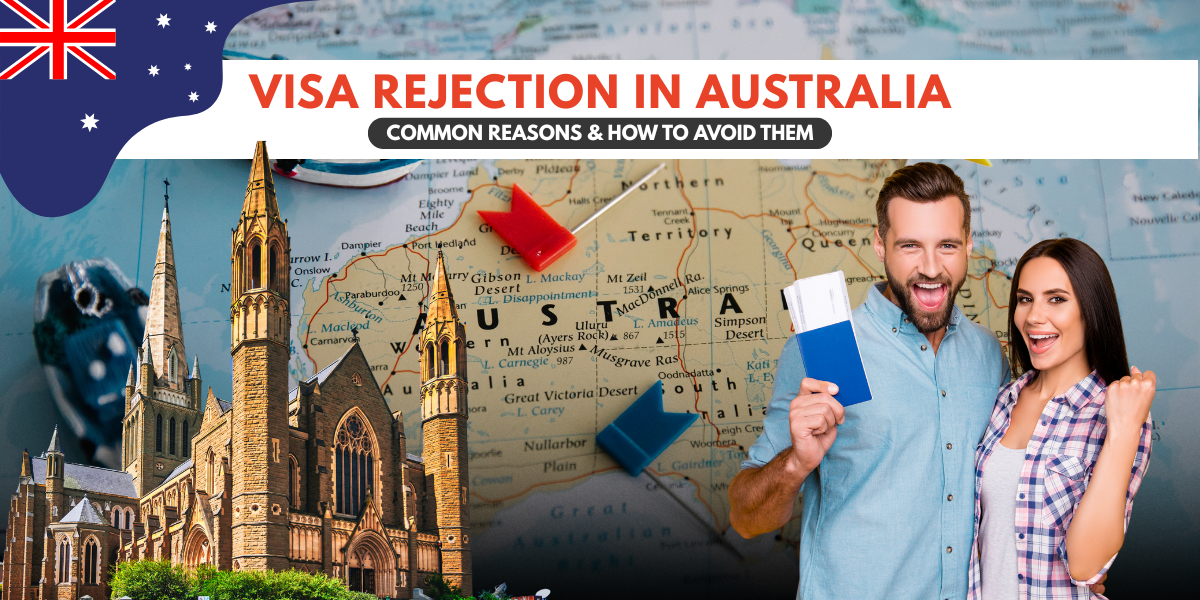
Australia remains one of the most popular destinations for international students, offering world-class universities, multicultural experiences, and promising post-study work opportunities. However, for many, the excitement of pursuing education in Australia can be dampened by one major obstacle—visa rejection. Understanding the reasons behind visa rejection in Australia and knowing how to avoid them can significantly improve your chances of getting your student visa approved.
In this guide, we break down the most common causes of visa rejection in Australia and offer practical tips to help you avoid mistakes during your application process.
- Incomplete or Incorrect Documentation
One of the most frequent reasons for visa rejection in Australia is submitting incomplete or incorrect documentation. The Australian Department of Home Affairs requires a range of documents, including proof of enrollment, financial evidence, English language proficiency, and a valid passport.
How to Avoid:
Ensure all documents are updated, accurate, and compliant with the visa checklist. Double-check everything before submission and seek professional help if you are unsure.
- Failure to Meet Genuine Temporary Entrant (GTE) Requirements
The GTE requirement confirms that the applicant intends to stay in Australia for study temporarily. If the visa officer doubts your intentions or finds inconsistencies in your SOP or supporting documents, it could lead to visa rejection in Australia.
How to Avoid:
Write a transparent and honest Statement of Purpose (SOP) that outlines your academic goals, ties to your home country, and plans after graduation. Be transparent and back up your claims with facts and documents.
- Insufficient Financial Proof
Australia requires international students to show they have enough funds to cover tuition fees, living expenses, travel, and other costs during their stay. Failing to demonstrate this can be a significant reason for visa rejection in Australia.
How to Avoid:
Provide legitimate, well-documented financial statements from recognized banks. Ensure the funds have been held for the required duration and are linked to you or your sponsor.
- Poor Academic Background or Gaps in Study
An unexplained academic gap or weak academic history might raise questions about your intent and ability to succeed in an Australian institution. If not addressed properly, this can contribute to visa rejection in Australia.
How to Avoid:
Use your SOP to explain any gaps honestly. Highlight your motivation to resume studies, provide supporting documents like work experience or certifications, and choose courses that align with your academic or professional background.
- Inadequate English Language Proficiency
English proficiency is a critical requirement. Submitting scores below the minimum requirement or failing to include test scores altogether can result in visa rejection in Australia.
How to Avoid:
Take recognized English tests such as IELTS, TOEFL, or PTE and meet the minimum score requirements of your course and visa subclass. Submit only valid, verifiable scores.
- Choosing the Wrong Course or Institution
Opting for a course unrelated to your previous education or professional experience can lead to visa rejection in Australia. It signals a potential red flag to the visa officer.
How to Avoid:
Pick a course that logically aligns with your academic history or career goals. Explain your rationale in your SOP and show how it supports your plans.
- Submitting Fraudulent Documents
Any attempt to provide fake documents, altered bank statements, or misleading information is a guaranteed way to face visa rejection in Australia. In severe cases, it can lead to a ban on reapplying.
How to Avoid:
Always provide genuine documents. Work with trusted education consultants or agencies, like Vision International, to ensure your application is authentic and professionally reviewed.
- Health and Character Concerns
Australia has strict health and character requirements. Not meeting medical or police clearance criteria can result in visa rejection.
How to Avoid:
Undergo the required medical examinations from authorized clinics and submit police clearance certificates promptly. Declare any health issues honestly and provide the necessary documentation.
- Lack of Clarity in SOP (Statement of Purpose)
A vague, poorly written, or inconsistent SOP can harm your application. The SOP is your voice in the visa process—if it’s unclear or appears insincere, it could result in visa rejection in Australia.
How to Avoid:
Invest time in crafting a strong SOP. Include your academic background, career plans, course relevance, reasons for choosing Australia, and how to use your education after returning home. Seek professional assistance if needed.
- Not Following Visa Guidelines or Deadlines
Missing deadlines or failing to follow specific visa guidelines and procedures is a common but avoidable cause of visa rejection in Australia.
How to Avoid:
Stay updated with the latest requirements on the Department of Home Affairs website. Start your visa process early and work with a reliable education consultant to ensure timely and accurate submission.
Conclusion
Although facing visa rejection in Australia can be discouraging, many reasons can be avoided with proper planning and guidance. From ensuring complete documentation to writing a strong SOP and meeting financial requirements, taking the right steps can significantly boost your chances of success.
At Vision International, we guide students through every visa process step—offering personalized assistance with applications, document verification, and interview preparation. Our expertise reduces the risk of visa rejection in Australia, giving you the confidence to start your academic journey without delays.
If you’re looking to study in Australia and want to avoid the common pitfalls, visit India’s 1st Hybrid Study Abroad Consultancy-Vision International’s Contact Us page or our FAQs to help you navigate your journey smoothly.